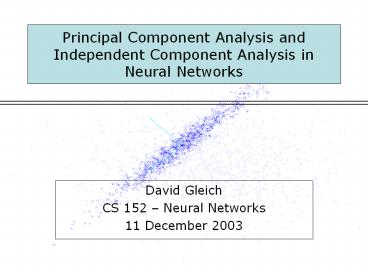Principal Component Analysis and Independent Component Analysis in Neural Networks - PowerPoint PPT Presentation
Title:
Principal Component Analysis and Independent Component Analysis in Neural Networks
Description:
Principal Component Analysis and Independent Component Analysis in Neural Networks ... 8 channel ECG from pregnant mother. Implementation ... – PowerPoint PPT presentation
Number of Views:835
Avg rating:3.0/5.0
Title: Principal Component Analysis and Independent Component Analysis in Neural Networks
1
Principal Component Analysis and Independent
Component Analysis in Neural Networks
- David Gleich
- CS 152 Neural Networks
- 11 December 2003
2
Outline
- Review PCA and ICA
- Neural PCA Models
- Neural ICA Models
- Experiments and Results
- Implementations
- Summary/Conclusion
- Questions
3
Principal Component Analysis
- PCA identifies an m dimensional explanation of n
dimensional data where m lt n. - Originated as a statistical analysis technique.
- PCA attempts to minimize the reconstruction error
under the following restrictions - Linear Reconstruction
- Orthogonal Factors
- Equivalently, PCA attempts to maximize variance.
4
Independent Component Analysis
- Also known as Blind Source Separation.
- Proposed for neuromimetic hardware in 1983 by
Herault and Jutten. - ICA seeks components that are independent in the
statistical sense. - Two variables x, y are statistically independent
iff P(x Å y) P(x)P(y). - Equivalently, Eg(x)h(y) Eg(x)Eh(y)
0where g and h are any functions.
5
Independent Component Analysis
- Given m signals of length n, construct the data
matrix - We assume that X consists of m sources such that
- X AS
- where A is an unknown m by m mixing matrix and S
is m independent sources.
6
Independent Component Analysis
- ICA seeks to determine a matrix W such that
- Y BX
- where W is an m by m matrix and Y is the set of
independent source signals, i.e. the independent
components. - B ¼ A-1 ) Y A-1AX X
- Note that the components need not be orthogonal,
but that the reconstruction is still linear.
7
PCA with Neural Networks
- Most PCA Neural Networks use some form of Hebbian
learning. - Adjust the strength of the connection between
units A and B in proportion to the product of
their simultaneous activations. - wk1 wk bk(yk xk)
- Applied directly, this equation is unstable.
- wk2 ! 1 as k ! 1
- Important Note neural PCA algorithms are
unsupervised.
8
PCA with Neural Networks
- Another fix Ojas rule.
- Proposed in 1982 by Oja and Karhunen.
- wk1 wk ?k(yk xk yk2 wk)
- This is a linearized version of the normalized
Hebbian rule. - Convergence, as k ! 1, wk ! e1.
9
PCA with Neural Networks
- Generalized Hebbian Algorithm
- y Wx
- ?wij,k?kyikxjk - ?kyik?liylkwlj,k
- ?W ?kyxT - ?kW LT(yyT)
10
PCA with Neural Networks
- APEX Model Kung and Diamantaras
- y Wx Cy , y (IC)-1Wx ¼ (I-C)Wx
11
PCA with Neural Networks
- APEX Learning
- Properties of APEX model
- Exact principal components
- Local updates, ?wab only depends on xa, xb, wab
- -Cy acts as an orthogonalization term
12
Neural ICA
- ICA is typically posed as an optimization
problem. - Many iterative solutions to optimization problems
can be cast into a neural network.
13
Feed-Forward Neural ICA
- General Network Structure
- Learn B such that y Bx has independent
components. - Learn Q which minimizes the mean squared error
reconstruction.
B
Q
x
x
y
14
Feed-Forward Neural ICA
- General Network Structure
- Learn B such that y Bx has independent
components.
B
x
y
15
Neural ICA
- Herault-Jutten local updates
- B (IS)-1
- Sk1 Sk bkg(yk)h(ykT)
- g t, h t3 g hardlim, h tansig
- Bell and Sejnowski information theory
- Bk1 Bk ?kBk-T zkxkT
- z(i) ?/?u(i) ?u(i)/?y(i)
- u f(Bx) f tansig, etc.
16
Neural ICA
- EASI (Equivariant Adaptive Separation via
Independence) Cardoso et al - Bk1Bk-?kykykTIg(yk)h(yk)T-(yk)g(yk)TBk
- gt, htansig(t)
17
Ojas Rule in Action
- Matlab Demo!
18
PCA Error Plots Close Eigenvalues
Final APEX error 3.898329 Final GHA error
3.710844 Minimum error 3.664792
19
PCA Error Plots Separate Eigenvalues
Final APEX error 2322.942988 Final GHA error
0.875660 Minimum error 0.082642
20
Observations
- Why just the PCA subspace?
- Bad Ojas example Matlab demo!
- Why can APEX fail?
- -Cy term continually orthogonalizes
21
ICA Image Example
22
ICA Image Example
Bell and Sejnowski
EASI
23
Real World Data
- 8 channel ECG from pregnant mother
24
Implementation
- Matlab sources for each neural algorithm, and
supporting functions - PCA oja.m gha.m apex.m
- ICA hj.m easi.m bsica.m
- Evaluation pcaerr.m
- Demos fetal_plots.m pca_error_plots.m
ojademo.m ica_image_demo.m - Data generators evalpca.m evalica.m
25
Future Work
- Investigate adaptive learning and changing
separations - Briefly examined this the published paper on ICA
adjusted the learning rate correctly, but didnt
converge to a separation. - Convergence of PCA algorithms based on eigenvalue
distribution? - Use APEX to compute more components than
desired?
26
Summary
- Neural PCA
- Algorithms work sometimes. They tend to find
the PCA subspace rather than the exact PCA
components - GHA is better than APEX
- Neural ICA
- Algorithms converge to something reasonable.
- Bell and Sejnowskis ICA possibly superior to
EASI.
27
Questions?
28
References
- Diamantras, K.I. and S. Y. Kung. Principal
Component Neural Networks. - Comon, P. Independent Component Analysis, a new
concept? In Signal Processing, vol. 36, pp.
287-314, 1994. - FastICA, http//www.cis.hut.fi/projects/ica/fastic
a/ - Oursland, A., J. D. Paula, and N. Mahmood. Case
Studies in Independent Component Analysis. - Weingessel, A. An Analysis of Learning
Algorithms in PCA and SVD Neural Networks. - Karhunen, J. Neural Approaches to Independent
Component Analysis. - Amari, S., A. Cichocki, and H. H. Yang.
Recurrent Neural Networks for Blind Separation
of Sources.































